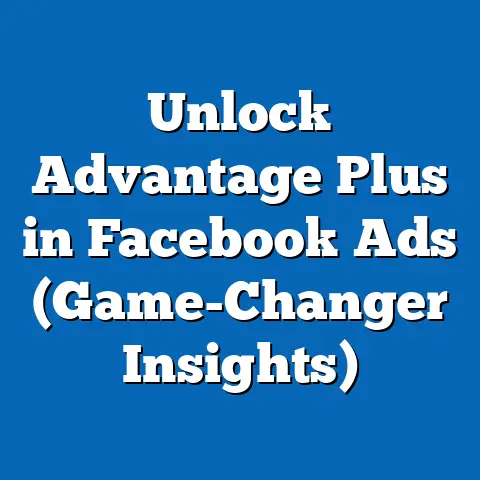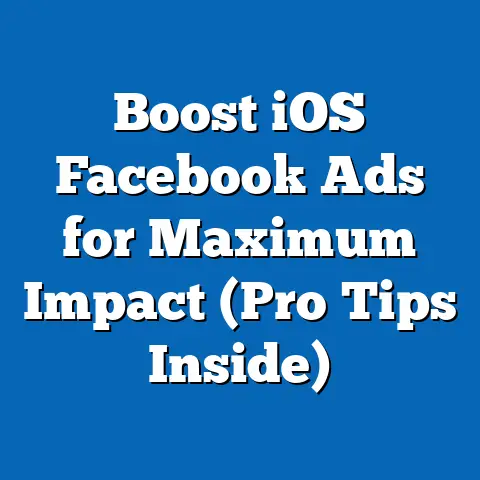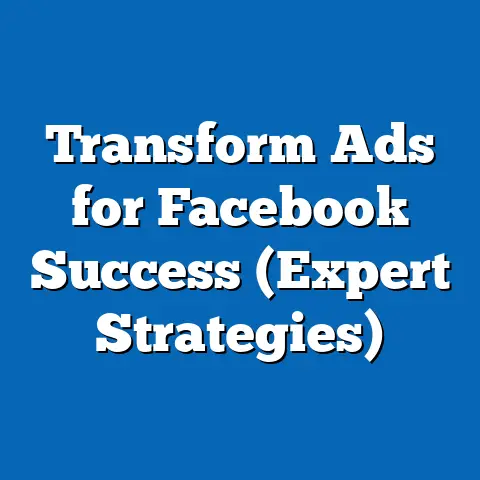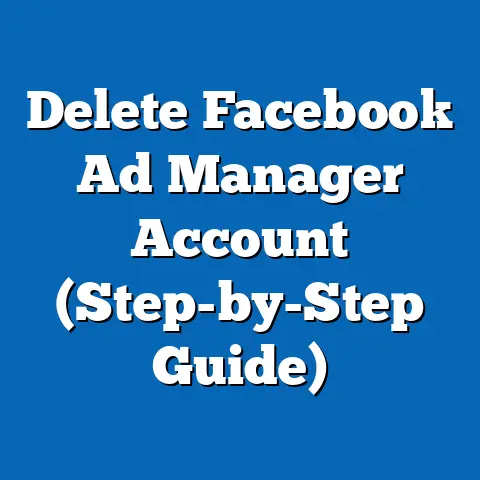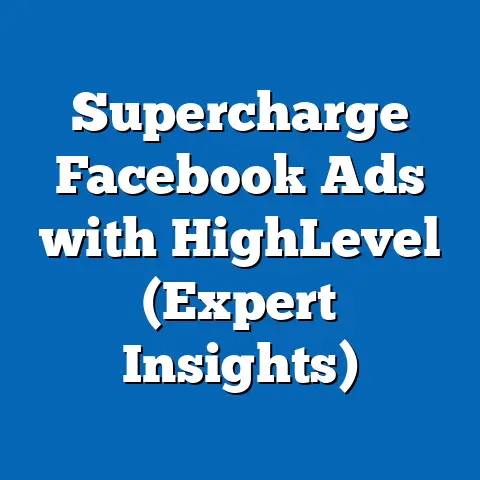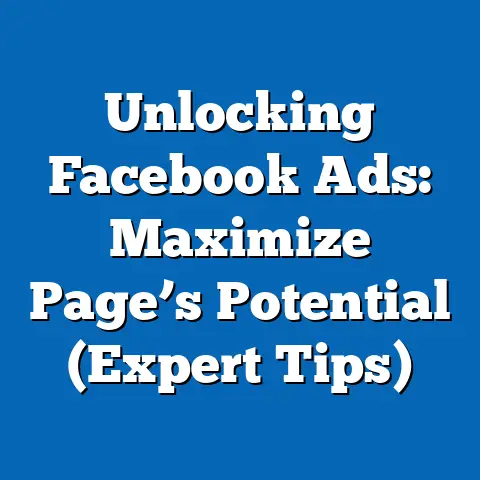Master Facebook Ads Monetization (Essential Guide)
Ever seen those TikTok stars effortlessly raking in the dough, flaunting their latest hauls and exotic vacations? It’s a modern-day gold rush, and while I’m not suggesting you become a dancing influencer (unless that’s your jam!), the principle of leveraging social media for income is incredibly relevant to businesses. Facebook, the OG of social media, offers a powerful avenue for monetization through its robust advertising platform. In today’s digital marketing landscape, where brands are increasingly shifting their focus to social media, understanding Facebook Ads is no longer optional—it’s essential.
I’ve personally witnessed countless businesses, from small startups to established enterprises, completely transform their marketing strategies by harnessing the power of Facebook Ads. It’s not just about throwing money at the platform; it’s about understanding the nuances, crafting compelling content, and strategically targeting the right audience. This guide is designed to be your comprehensive roadmap to mastering Facebook Ads monetization, providing you with the knowledge and tools to unlock the platform’s immense potential. Let’s dive in!
Understanding Facebook Ads
Facebook Ads are, quite simply, paid messages that businesses use to reach a specific audience on Facebook (and its sister platforms like Instagram). But they’re so much more than just glorified billboards. Unlike traditional advertising, Facebook Ads offer unparalleled targeting capabilities, allowing you to pinpoint your ideal customer with laser-like precision. Think of it as having a conversation with the people who are most likely to be interested in what you have to offer.
Facebook Ads fit seamlessly into the broader digital marketing ecosystem, working hand-in-hand with other strategies like SEO, email marketing, and content marketing. They provide a crucial boost to organic reach, which, let’s face it, has become increasingly challenging to achieve on Facebook.
There’s a diverse range of Facebook Ad formats to choose from, each with its own unique advantages:
-
Image Ads: Simple, clean, and effective for showcasing products or services with compelling visuals.
-
Video Ads: Highly engaging, perfect for storytelling and demonstrating product features. I’ve found that short, attention-grabbing videos tend to perform best.
-
Carousel Ads: Allow you to showcase multiple products or features in a single ad unit, each with its own image, headline, and link.
-
Slideshow Ads: Create a video-like experience using a series of still images, a cost-effective alternative to video ads.
Image Ads: Simple, clean, and effective for showcasing products or services with compelling visuals.
Video Ads: Highly engaging, perfect for storytelling and demonstrating product features. I’ve found that short, attention-grabbing videos tend to perform best.
Carousel Ads: Allow you to showcase multiple products or features in a single ad unit, each with its own image, headline, and link.
Slideshow Ads: Create a video-like experience using a series of still images, a cost-effective alternative to video ads.
The beauty of Facebook Ads lies in their ability to be hyper-targeted. According to Facebook’s own data, tailored ads can outperform generic campaigns by as much as 3x in terms of engagement and conversion rates. This is because Facebook allows you to target users based on a vast array of criteria, including demographics, interests, behaviors, and even their connections. This level of granularity ensures that your ads are seen by the people who are most likely to be interested in what you have to offer.
Takeaway: Facebook Ads are a powerful tool for reaching your target audience with tailored messages, boosting organic reach, and driving conversions. Understanding the different ad formats and leveraging Facebook’s targeting capabilities is key to success.
Setting Up Your Facebook Ads Account
Before you can start monetizing with Facebook Ads, you need to set up your account properly. This process involves a few key steps:
-
Create a Facebook Business Manager Account: This is the central hub for managing all your Facebook business assets, including your Facebook Page, ad accounts, and team members. If you don’t have one already, head over to business.facebook.com and create one. I’ve found that having a well-organized Business Manager account makes managing multiple ad campaigns much easier.
-
Create an Ad Account: Within your Business Manager, you’ll need to create an ad account. This is where you’ll actually manage your campaigns, set your budget, and track your performance.
-
Link Your Facebook Page: Connect your Facebook Page to your ad account. This allows you to run ads that appear to be coming directly from your business.
-
Link Your Instagram Account (Optional but Recommended): If you have an Instagram account, linking it to your ad account allows you to run ads on both platforms simultaneously, expanding your reach and potential for monetization. This is especially beneficial if your target audience is active on Instagram.
-
Set Up Your Payment Information: Add your credit card or PayPal account to your ad account to pay for your advertising spend.
Create a Facebook Business Manager Account: This is the central hub for managing all your Facebook business assets, including your Facebook Page, ad accounts, and team members. If you don’t have one already, head over to business.facebook.com and create one. I’ve found that having a well-organized Business Manager account makes managing multiple ad campaigns much easier.
Create an Ad Account: Within your Business Manager, you’ll need to create an ad account. This is where you’ll actually manage your campaigns, set your budget, and track your performance.
Link Your Facebook Page: Connect your Facebook Page to your ad account. This allows you to run ads that appear to be coming directly from your business.
Link Your Instagram Account (Optional but Recommended): If you have an Instagram account, linking it to your ad account allows you to run ads on both platforms simultaneously, expanding your reach and potential for monetization. This is especially beneficial if your target audience is active on Instagram.
Set Up Your Payment Information: Add your credit card or PayPal account to your ad account to pay for your advertising spend.
Once you have your ad account set up, it’s important to create a compelling business profile that attracts potential customers. This includes:
-
A Professional Profile Picture: Use your company logo or a high-quality image that represents your brand.
-
A Clear and Concise Description: Explain what your business does and what value you offer to customers.
-
A Link to Your Website: Make it easy for people to learn more about your business and make a purchase.
-
A Call to Action Button: Encourage people to take a specific action, such as “Shop Now,” “Learn More,” or “Contact Us.”
A Professional Profile Picture: Use your company logo or a high-quality image that represents your brand.
A Clear and Concise Description: Explain what your business does and what value you offer to customers.
A Link to Your Website: Make it easy for people to learn more about your business and make a purchase.
A Call to Action Button: Encourage people to take a specific action, such as “Shop Now,” “Learn More,” or “Contact Us.”
Takeaway: Setting up your Facebook Ads account properly is crucial for running successful campaigns. Make sure to create a Business Manager account, link your Facebook and Instagram accounts, and create a compelling business profile that attracts potential customers.
Crafting Compelling Ad Content
Now that you have your ad account set up, it’s time to create compelling ad content that captures attention and drives results. This is where your creativity and storytelling skills come into play.
High-performing ad copy should be:
-
Clear and Concise: Get straight to the point and explain what you’re offering in a way that’s easy to understand.
-
Benefit-Oriented: Focus on the benefits that customers will receive by using your product or service, rather than just listing features.
-
Emotionally Appealing: Connect with your audience on an emotional level by tapping into their desires, fears, or aspirations.
-
Urgent: Create a sense of urgency by using words like “limited time offer” or “shop now before it’s too late.”
Clear and Concise: Get straight to the point and explain what you’re offering in a way that’s easy to understand.
Benefit-Oriented: Focus on the benefits that customers will receive by using your product or service, rather than just listing features.
Emotionally Appealing: Connect with your audience on an emotional level by tapping into their desires, fears, or aspirations.
Urgent: Create a sense of urgency by using words like “limited time offer” or “shop now before it’s too late.”
Visuals are equally important. Your ad images or videos should be:
-
High-Quality: Use professional-looking images or videos that are visually appealing and represent your brand well.
-
Relevant: Choose visuals that are relevant to your ad copy and target audience.
-
Eye-Catching: Use bright colors, interesting compositions, and engaging elements to grab attention.
-
Consistent with Your Brand: Maintain a consistent visual style across all your ads to reinforce your brand identity.
High-Quality: Use professional-looking images or videos that are visually appealing and represent your brand well.
Relevant: Choose visuals that are relevant to your ad copy and target audience.
Eye-Catching: Use bright colors, interesting compositions, and engaging elements to grab attention.
Consistent with Your Brand: Maintain a consistent visual style across all your ads to reinforce your brand identity.
One of the most effective ways to improve your ad content is through A/B testing. This involves creating multiple versions of your ad with different headlines, calls to action, images, or videos, and then running them simultaneously to see which one performs best. I’ve personally seen A/B testing dramatically improve ad performance by identifying the elements that resonate most with the target audience.
Video content is also playing an increasingly important role in Facebook Ads. According to recent statistics, video ads have significantly higher engagement rates compared to static ads. This is because videos are more visually appealing and can convey more information in a shorter amount of time.
Takeaway: Crafting compelling ad content is crucial for capturing attention and driving results. Use clear and concise copy, benefit-oriented messaging, emotionally appealing elements, and high-quality visuals. Don’t forget to A/B test different versions of your ad to optimize performance and leverage the power of video content.
Targeting Your Audience
The beauty of Facebook Ads lies in its ability to target your audience with incredible precision. This means you can show your ads to the people who are most likely to be interested in what you have to offer, maximizing your ad spend and driving conversions.
Facebook offers a wide range of targeting options, including:
-
Demographics: Target users based on age, gender, location, education, and other demographic factors.
-
Interests: Target users based on their interests, hobbies, and passions.
-
Behaviors: Target users based on their online behavior, such as their purchase history, website visits, and app usage.
-
Custom Audiences: Create custom audiences by uploading a list of your existing customers or website visitors.
-
Lookalike Audiences: Create lookalike audiences by identifying users who share similar characteristics with your existing customers. This is a powerful way to expand your reach and find new potential customers.
Demographics: Target users based on age, gender, location, education, and other demographic factors.
Interests: Target users based on their interests, hobbies, and passions.
Behaviors: Target users based on their online behavior, such as their purchase history, website visits, and app usage.
Custom Audiences: Create custom audiences by uploading a list of your existing customers or website visitors.
Lookalike Audiences: Create lookalike audiences by identifying users who share similar characteristics with your existing customers. This is a powerful way to expand your reach and find new potential customers.
Retargeting is another effective strategy for maximizing ad reach and effectiveness. This involves showing ads to people who have previously interacted with your website or Facebook Page. For example, you can retarget people who have viewed a specific product on your website or added an item to their shopping cart but haven’t completed the purchase.
Facebook Insights is a valuable tool for analyzing audience behavior and refining your targeting strategies. This tool provides detailed information about your audience’s demographics, interests, and behaviors, allowing you to gain a deeper understanding of who you’re trying to reach.
Takeaway: Targeting your audience with precision is crucial for maximizing your ad spend and driving conversions. Leverage Facebook’s diverse targeting options, create lookalike audiences, and use retargeting strategies to reach the right people with the right message. Don’t forget to use Facebook Insights to analyze audience behavior and refine your targeting strategies.
Budgeting and Bidding Strategies
Setting the right budget and choosing the right bidding strategy are essential for maximizing your ROI with Facebook Ads.
Facebook offers two main budgeting options:
-
Daily Budget: Set a fixed amount that you’re willing to spend each day. This is a good option for campaigns that you want to run continuously.
-
Lifetime Budget: Set a total amount that you’re willing to spend over the entire duration of your campaign. This is a good option for campaigns that have a specific end date.
Daily Budget: Set a fixed amount that you’re willing to spend each day. This is a good option for campaigns that you want to run continuously.
Lifetime Budget: Set a total amount that you’re willing to spend over the entire duration of your campaign. This is a good option for campaigns that have a specific end date.
When it comes to bidding strategies, Facebook offers two main approaches:
-
Automatic Bidding: Facebook automatically sets your bids to get the most results for your budget. This is a good option for beginners who are not familiar with bidding strategies.
-
Manual Bidding: You manually set your bids based on your target cost per result. This gives you more control over your ad spend, but it requires more knowledge and experience.
Automatic Bidding: Facebook automatically sets your bids to get the most results for your budget. This is a good option for beginners who are not familiar with bidding strategies.
Manual Bidding: You manually set your bids based on your target cost per result. This gives you more control over your ad spend, but it requires more knowledge and experience.
The best bidding strategy for you will depend on your goals and your level of expertise. If you’re just starting out, I recommend using automatic bidding to get a feel for how the platform works. As you gain more experience, you can experiment with manual bidding to try to optimize your ROI.
It’s also important to monitor and adjust your ad spend based on performance metrics. If you see that your ads are performing well, you can increase your budget to reach more people. If your ads are underperforming, you can decrease your budget or pause the campaign altogether.
Takeaway: Setting the right budget and choosing the right bidding strategy are essential for maximizing your ROI with Facebook Ads. Consider your goals and level of expertise when choosing your budgeting and bidding options. Don’t forget to monitor and adjust your ad spend based on performance metrics.
Measuring Success and Optimizing Campaigns
Measuring the success of your Facebook Ads campaigns is crucial for understanding what’s working and what’s not. This allows you to optimize your campaigns and improve your ROI over time.
Some key performance indicators (KPIs) to track include:
-
Click-Through Rate (CTR): The percentage of people who see your ad and click on it. A high CTR indicates that your ad is relevant and engaging.
-
Conversion Rate: The percentage of people who click on your ad and then complete a desired action, such as making a purchase or filling out a form. A high conversion rate indicates that your landing page is effective and your offer is compelling.
-
Cost Per Acquisition (CPA): The average cost of acquiring a new customer through your Facebook Ads campaign. A low CPA indicates that your campaign is efficient and cost-effective.
Click-Through Rate (CTR): The percentage of people who see your ad and click on it. A high CTR indicates that your ad is relevant and engaging.
Conversion Rate: The percentage of people who click on your ad and then complete a desired action, such as making a purchase or filling out a form. A high conversion rate indicates that your landing page is effective and your offer is compelling.
Cost Per Acquisition (CPA): The average cost of acquiring a new customer through your Facebook Ads campaign. A low CPA indicates that your campaign is efficient and cost-effective.
Facebook Ads Manager is a powerful tool for tracking performance and gathering insights. This tool provides detailed data on your ad impressions, clicks, conversions, and other key metrics.
Regularly optimizing your campaigns based on data analysis is essential for maximizing your ROI. This includes:
-
Pausing Underperforming Ads: If you see that certain ads are not performing well, pause them and reallocate your budget to high-performing ads.
-
Adjusting Your Targeting: If you’re not reaching the right audience, refine your targeting criteria to reach more relevant users.
-
Improving Your Ad Content: If your ad content is not engaging or driving conversions, experiment with different headlines, calls to action, images, or videos.
-
Testing Different Bidding Strategies: If you’re not getting the results you want with your current bidding strategy, try a different approach.
Pausing Underperforming Ads: If you see that certain ads are not performing well, pause them and reallocate your budget to high-performing ads.
Adjusting Your Targeting: If you’re not reaching the right audience, refine your targeting criteria to reach more relevant users.
Improving Your Ad Content: If your ad content is not engaging or driving conversions, experiment with different headlines, calls to action, images, or videos.
Testing Different Bidding Strategies: If you’re not getting the results you want with your current bidding strategy, try a different approach.
Takeaway: Measuring the success of your Facebook Ads campaigns is crucial for understanding what’s working and what’s not. Track key performance indicators, use Facebook Ads Manager to gather insights, and regularly optimize your campaigns based on data analysis.
Conclusion
Mastering Facebook Ads monetization is essential for businesses in today’s digital landscape. By understanding the platform’s capabilities, crafting compelling content, strategically targeting the right audience, and continuously optimizing your campaigns, you can unlock the immense potential of Facebook Ads and drive significant results for your business.
I encourage you to take actionable steps toward implementing the strategies discussed in this guide and unlocking the potential of Facebook Ads for your own monetization efforts. The world of Facebook Ads is constantly evolving, so stay curious, keep learning, and never stop experimenting.
And remember, the journey to mastering Facebook Ads is a marathon, not a sprint. Be patient, persistent, and data-driven, and you’ll be well on your way to achieving your monetization goals. Now go out there and make some magic happen!
Call to Action: I’d love to hear about your experiences with Facebook Ads. Share your thoughts and questions in the comments below, or connect with me on social media for further discussion. Let’s learn and grow together!

